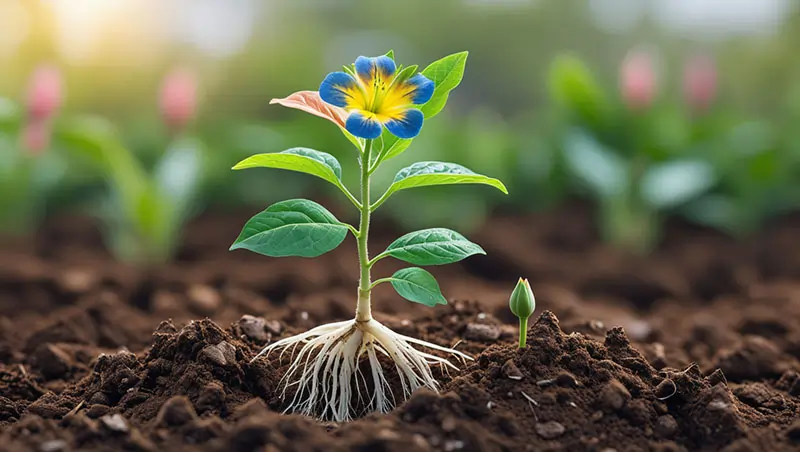Understanding the Parts of a Plant: A Visual Science Guide for Kids
Plant anatomy for kids made simple!
1. Introduction to Plant Structure
Any garden or park will show you a variety of shapes and sizes of plants just looking about. Still, practically every green friend you come across—from a small pot of basil to a massive mango tree—has the same basic body scheme. Understanding these parts of a plant clarifies our knowledge of the growth, feeding, and reproduction of living things. We’ll tour the “plant body,” investigate each section’s work, and add in activities, fun facts, and printable goodies to keep young scientists occupied in this guide.
2. Functions of Each Part
| Plant Part | What It Looks Like | Main Job | Kid‑Friendly Memory Trick |
| Roots | Hair‑like or thick, underground | Drink & anchor – roots slurp up water/minerals and hold the plant steady | Think of a straw stuck in the soil, sipping water! |
| Stem | Green/brown “trunk” rising from roots | Lift & move – carries water up, food down, and keeps leaves aimed at sunlight | Like an elevator shaft for water and food parcels |
| Leaves | Flat, green “solar panels” | Make food – use sunlight + CO₂ + water to cook sugar via photosynthesis | Leaves = little kitchens powered by sunshine |
| Flowers | Colorful petals with yummy smells | Create seeds – attract pollinators and start the next plant generation | Flowers throw a party so bees visit and help make seeds |

3. How Plants Grow and Survive
- Seed stage: Food plus a little package containing an embryo baby plant.
- Germination: Roots emerge first, then a shoot running for light.
- Seedling: Mini stems and the first leaves—cotyledons—unfold from the seedling.
- Mature plant: Mature plants show full-sized roots, stems, leaves, and flowers.
- Reproduction: Flowers become fruits or seed pods; seeds drop, fly, or get carried away; the cycle restarts!

4. Diagram Labeling Activity
Grab the printable blank diagram (see “Printable Resources” below).
Challenge:
- Cut out the word cards: “roots,” “stem,” “leaf,” “flower.”
- Glue or tape each label in the correct spot.
- Color-code: shade roots brown, stem green, leaves darker green, and flowers any color you like.
Teacher hint: Slip the sheet into a plastic sleeve and use dry‑erase markers so kids can repeat the activity.

5. Interactive Worksheets and Games
| Activity | What to Do | Skills Practiced |
| Plant Part Bingo | Each square shows a simple drawing (e.g., “roots slurping water”). Call out clues like “the plant’s drinking straw,” and kids cover the matching picture. | Vocabulary & listening |
| Growth Timeline Cut‑and‑Paste | Provide scrambled pictures of seed → mature plant. Kids glue them in correct order on a timeline strip. | Sequencing & life cycles |
| Photosynthesis Dance | Assign roles: Sun, Leaf, Water, Carbon Dioxide. Kids act out moving into the leaf and turning into “Sugar” + “Oxygen” dancers. | Concept reinforcement & kinesthetic learning |
| Online drag‑and‑drop quiz (linkable in Google Slides) | Kids drag labels onto a cartoon plant. Wrong spot? It snaps back—try again! | Digital skills & self‑correction |
6. Fun Plant Facts
- ? Tall tale: Hyperion, a coast redwood, is taller than the Statue of Liberty!
- ? Night shift: Some desert cactus bloom only at night so bats, not bees, pollinate them.
- ? Plant pizza: Without plants we’d lose tomato sauce, wheat crust, basil topping—almost the whole pie.
- ? Real superheroes: Plants make their own food. No animal—including us—can pull off that trick!
- ? Ancient grains: Wheat was first cultivated some 10,000 years ago; modern wheat plants still have the same fundamental features of their wild counterparts.
7. Summary and Quick Quiz
Wrap‑up:
Though every root, stem, leaf, and bloom is a specialized worker on a mission—drinking, transporting, cooking, or generating the next generation—plants seem simple. When these components cooperate, the plant not only survives but also facilitates the breathing and eating of innumerable creatures, including humans.
5‑Question Quiz
- Which part of a plant anchors it and absorbs water?
- What process happens in leaves making food?
- True or False: Stems only carry water upward.
- Flowers attract pollinators mainly to…?
- Put these in life‑cycle order: seedling, seed, mature plant.
(Answers: 1 Roots; 2 Photosynthesis; 3 False—stems move food down too; 4 Create seeds; 5 Seed → Seedling → Mature plant)
8 . Printable Resources
- Blank plant diagram (labeling sheet) – PDF
- Plant Part Bingo cards – 8 unique boards + clue list
- Life‑cycle timeline strip – pictures & blank timeline
- Quiz answer key – for quick grading
- Mini‑poster: “Plant Highway” infographic – arrows showing water & sugar flow
Download PDF printable resources
Teacher tech tip: For durability, print on thick paper or upload these PDFs to your class drive. If at all possible, laminate; children can then rework them with dry erase markers.
With this visual, hands‑on guide, children don’t just read about plant anatomy—they color it, dance it, label it, and quiz themselves. Happy planting (and learning)!
Related resources: Free Science Lessons for Kids


